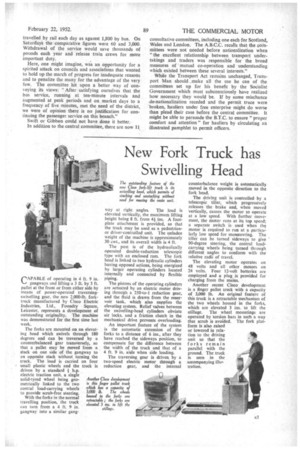New Fork Truck has Swivelling Head
Page 37

If you've noticed an error in this article please click here to report it so we can fix it.
rAPABLE of operating in 4 ft. 9 in.
gangways and lifting a 3 ft. by 3 ft. pallet at the front or from either side by means of power-operated traversingswivelling gear, the new 2,000-1b. forktruck manufactured by Cleco Electric Industries, Ltd., Foundry Square, Leicester, represents a development of outstanding originality. The machine was demonstrated for the first time last week.
The forks are mounted on an elevating head which swivels through 180 degrees and can be traversed by a counterbalanced gear transversely, so that a pallet may be moved from a stack on one side of the gangway to an opposite stack without turning the truck. The load is carried on four small plastic wheels and the truck is
driven by a standard h.p. electric traction unit, a single solid-tyred wheel being geometrically linked to the two central load-carrying wheels to provide scrub-free steering.
With the forks in the normal travelling position, the truck can turn from a 4 ft. 9 in. gangway into a similar gang
way at right angles. The load is elevated vertically, the maximum lifting height being 8 ft. from 44. ins. A footplate attachment is provided, so that the truck may be used as a pedestrianor driver-controlled unit. The unladen weight of the machine is approximately 30 cwt., and its overall width is 4 ft.
The post is of the hydraulically operated double-reduction telescopic type with an enclosed ram. The fork head is linked to two hydraulic cylinders having opposed actions, being energized by larger operating cylinders located internally and connected by flexible piping.
The pistons of the operating cylinders are actuated by an electric motor driving through a 250-to-I reduction gear, and the fluid is drawn from the reservoir tank, which also supplies the elevating system. Relief valves between the swivelling-head cylinders obviate air locks, and a friction clutch in the mechanical drive prevents overloading.
An important feature of the system is the automatic extension of the forks to a distance of 6 ins., after they have reached the sideways position, to compensate for the difference between the width of the truck and that of a 4 ft. 9 in. aisle when side loading.
The traversing gear is driven by a two-speed electric motor through a reduction gear, and the internal counterbalance weight is automatically moved in the opposite direction to the fork head.
The driving unit is controlled by a telescopic tiller, which progressively releases the brake and, when moved vertically, causes the motor to operate at a low speed. With further movement, the motor runs at its top speed; a separate switch is used when the motor is required to run at a particularly low speed for manceuvring. The tiller can be turned sideways to give 90-degree steering, the central loadcarrying wheels being turned through different angles to conform with the relative radii of travel.
The elevating motor operates on 48 volts and all other motors on 24 volts. Four 12-volt batteries are employed and a plug is provided for charging from the mains.
Another recent Cleco development is a finger pallet truck with a capacity of 3,000 lb. An original feature of this truck is a retractable mechanism of the two wheels housed in the forks, which are elevated 3 ins, to lift the stillage. The wheel mountings are operated by torsion bars in such a way that scrub is avoided. The fork platform is also raised or lowered in relation to the driving unit so that the forks remain parallel with the ground. The truck is seen in the accompanying illu tration.




















































































